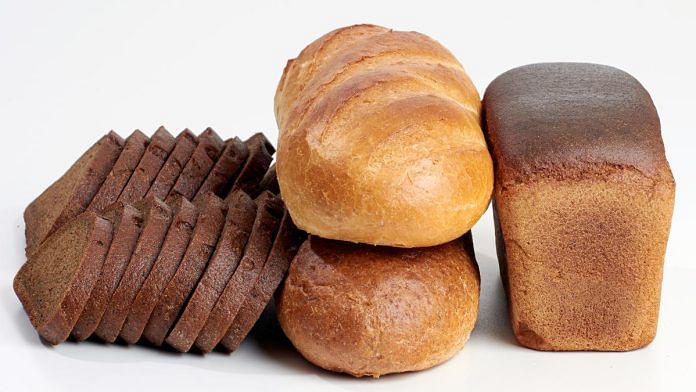Humans have been eating bread in some form for centuries. But modern bread is a far cry from the bread of the past. In its sliced bread form, it often contains so many more ingredients than the kind our ancestors were eating that it is now widely considered an ultra-processed food. But, this doesn’t necessarily mean it’s bad for us.
There are many definitions of what makes a food ultra-processed. The most commonly used one is the Nova classification, which was developed by researchers at the University of Sao Paulo in Brazil. This separates foods into four groups.
The first group includes unrefined or minimally processed foods such as vegetables or meat with no additives. Second are culinary ingredients which have come from natural sources, but have been milled or processed to make them easier to cook with or edible – such as flour.
The third group covers processed foods. These are made by combining ingredients, including fats, sugar and salt. Examples include homemade or bakery breads. The last are ultra-processed foods. These are either industrially processed in a factory or include ingredients not typically used in the home, such as additives like emulsifiers.
Since most sliced bread is made using the Chorleywood process, this would technically make it an ultra-processed food. The Chorleywood process was invented in the 1960s to produce bread faster on an industrial scale.
The process involves using more rapid mixing and more yeast, along with the addition of solid fats, emulisifiers and ascorbic acid (vitamin C). This allows more water and lower-protein flours to be used in the bread-making process, alongside the use of a vacuum to control the proving process. This creates the soft, fluffy bread we buy from the supermarket.
Although this process has enabled affordable, consistent bread, there are growing concerns about how healthy it actually is because it’s ultra-processed. This concern has partly been fuelled by mounting evidence showing a link between ultra-processed foods and health problems including heart disease, type 2 diabetes and some cancers.
However, researchers still don’t know if eating ultra-processed foods directly causes these health conditions. Nor do they know if only specific ingredients within these foods are to blame.
Bread’s position as an unhealthy, ultra-processed food has also been challenged. Some researchers argue the Nova classification’s definition of “ultra-processed” is oversimplified, leading many foods to be lumped into the same category despite containing vastly different ingredients and going through different processing methods.
It’s true supermarket bread contains emulsifiers, which have been linked with health problems, including a potentially increased risk of developing some cancers. But typically bread only uses mono- or diglyceride fatty acids as emulsifiers, which have not been linked to risk of disease.
It’s also worth noting that during the long fermentation processes used in traditional bread making, similar compounds to these two emulsifiers will actually be made by the yeasts and bacteria. These emulsifiers are used to improve the texture and, alongside hard fats (such as palm oil), help extend the bread’s shelf life.
Besides, the most important issue might not be whether the bread is classed as ultra-processed or not. The levels of salt in shop-bought bread could be more of a problem. Salt is used to even out how bread rises and give a consistent texture.
But the amount of salt in different brands of bread can vary from a teaspoon per loaf (similar to most homemade recipes) to four teaspoons per loaf. Look out for sodium levels on the label, and aim to purchase bread with less than 0.7g of salt per 100g (or 0.3g of sodium per 100g).
And, despite similar concerns, the sugar in modern supermarket bread may not be as bad as many think. Sugar is used to help the yeast ferment and rise before baking. As such, most bread contains 2g-4g of sugar per 100g. Some of this actually naturally occurs as a result of the proving process. However, this may vary depending on the brand.
Other considerations
So, it’s likely that the ultra-processed way bread is made might not be as big an issue to our health as some think – although the salt content in some loaves might be.
Brown bread (such as wholemeal or wholegrain) goes through a similar production process as white bread. The main difference is that it may have some fibre either retained or added back into the flour.
Fibre is important for maintaining healthy bowels. Bread (and even flat breads or pitta) which contains seeds or bits of grain may also have the added benefit of taking longer to digest. This can help to make you feel fuller longer.
Sourdough is another favoured option, with many saying it’s healthier because it uses more traditional baking processes. There is evidence that traditional French breads, which are slowly fermented and made with a sourdough starter, raise blood glucose (sugar) and insulin levels less than typical sliced loaves. As with higher fibre versions, this could mean they keep us feeling fuller for longer.
But many supermarket breads labelled “sourdough” may not be traditionally made. One of the problems is a lack of legally recognised definition for soughdough bread. In some countries it can only contain flour, water and salt (maybe with a little oil), but in others it can contain yeast to speed up fermentation and proving – and even additives. So if you’re looking for a real, traditional sourdough loaf, check that it only contains flour, water and salt.
Although supermarket bread may be classified as ultra-processed, that doesn’t mean you can’t include it as part of a balanced diet. Just be sure to think about what you’re putting on your toast. A sausage sandwich is less healthy than topping your toast with tinned tomatoes or baked beans.
Duane Mellor, Lead for Evidence-Based Medicine and Nutrition, Aston Medical School, Aston University
This article is republished from The Conversation under a Creative Commons License. Read original article.
Also read: Exposure to dioxins may worsen thyroid function: Study



